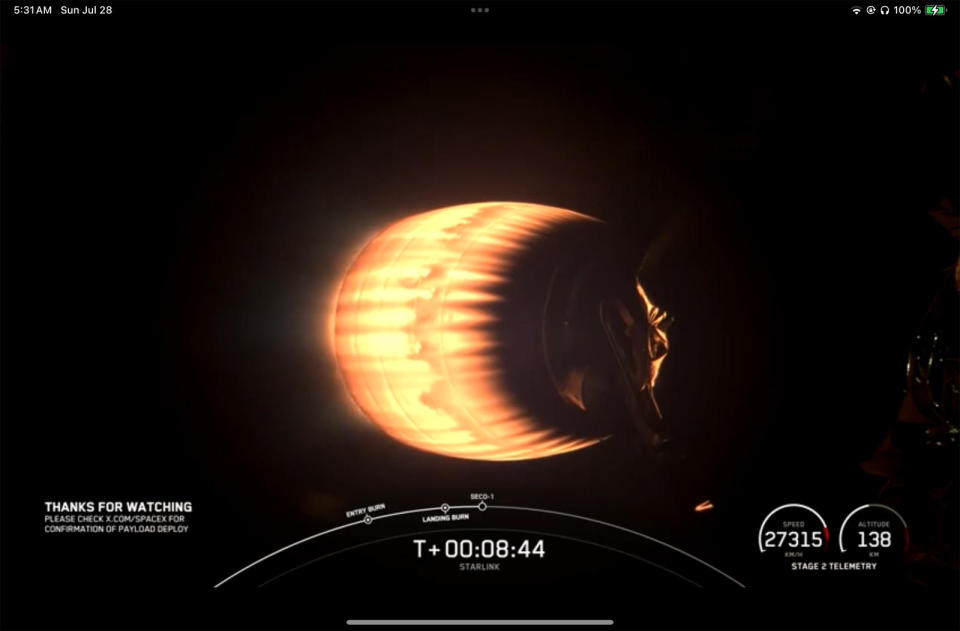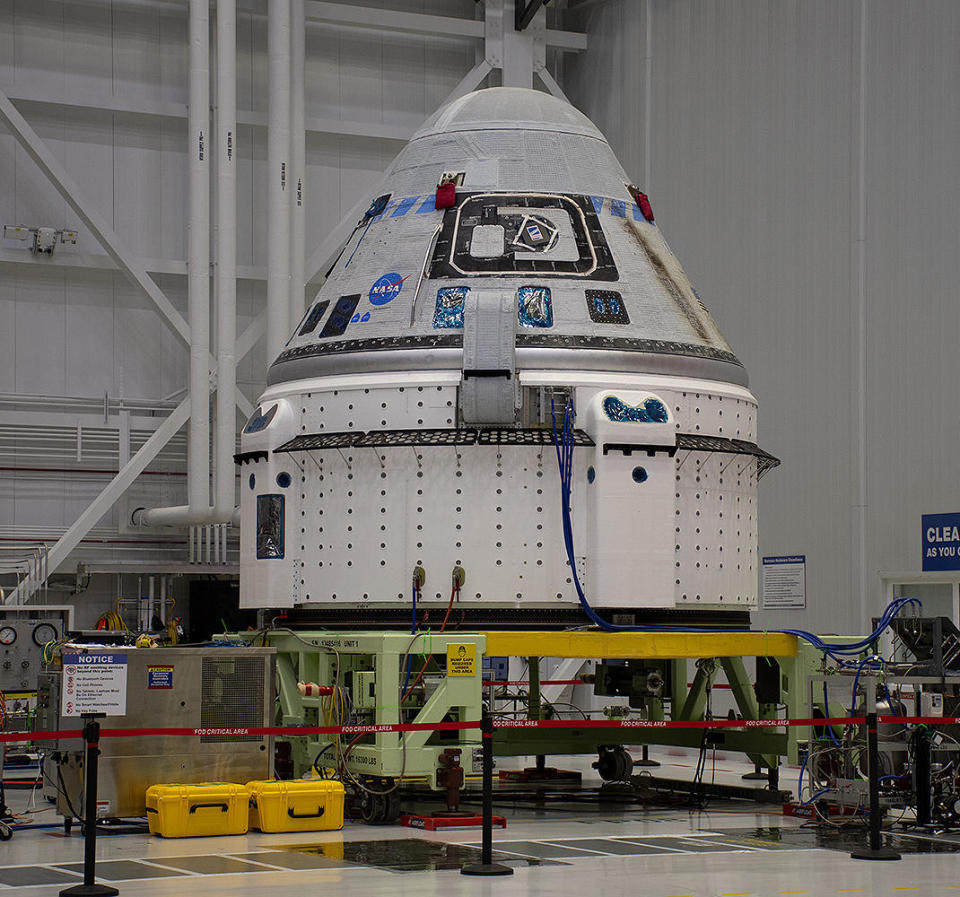SpaceX quickly launched three Falcon 9 rockets over the weekend, putting 67 Starlink satellites into orbit in three days after receiving approval to resume launches following a rare in-flight failure on July 11.
SpaceX kicked off its return to flight early Saturday with the launch of 23 Starlink internet satellites from Kennedy Space Center, followed by a second Starlink launch early Sunday from Cape Canaveral Space Force Station that put 23 more broadband relay stations into orbit. The third Falcon 9 launched a few hours later from Vandenberg Space Force Base in California.
All three flights appeared to be uneventful.
NASA is counting on Falcon 9s to launch a Northrop Grumman Cygnus resupply ship to the International Space Station on Aug. 3, followed by a SpaceX Crew Dragon flight around Aug. 18 that will carry three agency astronauts and a Russian cosmonaut to the lab.
The second stage, Crew 9, planned for piloted flight, will undergo a test firing at a SpaceX facility near McGregor, Texas, in the coming days to verify that the company’s corrective action will not lead to unforeseen consequences.

“Around July 30, the second stage will undergo a hot burn to check for any new changes the vehicle will undergo as a result of the anomaly,” Steve Stich, NASA’s Commercial Crew Program manager, said in a statement Friday.
“We are following the FAA’s investigation step by step. SpaceX has been very transparent, we have engaged our teams in the investigation and have tracked all changes to the booster.”
The space agency has yet to officially approve these flights, but SpaceX’s successful return to flights this weekend will no doubt play a role in the final decision.
Boeing engineers also had a busy weekend, successfully testing 27 of the company’s maneuvering thrusters. The Starliner capsule is now docked with the International Space Station.
The tests confirmed that the previously problematic reaction control system (RCS) thrusters were performing well, and confirmed that known helium leaks in the capsule’s propulsion system remained stable and were not worsening.
Tests show that the thrusters will function properly during the ship’s return to Earth.
“Single-pulse firings were designed to verify the performance of each thruster,” Boeing wrote in an update. “In between each firing, the team reviewed real-time data and all thrusters were performing at their highest thrust rating values.
“The helium system also remained stable,” the company said. “Additionally, an RCS oxidizer isolation valve that had previously not fully seated (Saturday) was actuated several times during testing and is now operating normally.”
The spacecraft’s first piloted test flight took place on June 5. The Starliner crew – commander Barry “Butch” Wilmore and co-pilot Sunita Williams — was initially expected to spend about eight days in space.
The mission took about two months due to work to fix thruster issues and fix five helium leaks, one detected before launch and four that developed during the capsule’s rendezvous with the space station.
NASA is expected to conduct a comprehensive review this weekend to evaluate the test data and determine whether the craft is ready to return Wilmore and Williams safely to Earth.


As for SpaceX and the Falcon 9, the company said the July 11 failure was due to a crack in the upper stage sensor line caused by a loose bracket and metal fatigue, which led to a liquid oxygen leak.
The leak caused extremely low temperatures in the engine’s pipes, slowing down the flow of fluid needed to restart the power unit for the planned second “burnout.”
Instead, the engine suffered a “hard start” that damaged multiple components, preventing the rocket from reaching its planned orbit. While the stage remained intact, the Starlinks it carried into space were dropped into a much lower orbit than planned and later burned up in the atmosphere.
Sarah Walker, a senior manager at SpaceX, said Friday that the “sense line” was not needed and would simply be removed from downstream rockets. She said the data it provided could be obtained from other telemetry sources on the rocket.
As for piloted Crew Dragon flights, he added that the second stage engine only fired once and that the leak that derailed the Starlink launch would not be a factor in a crewed flight. In either case, the leaky connector would be removed.
“I have the utmost confidence in the team, the integrated approach that NASA is taking to the response,” said Crew 9 co-pilot and Russian Soyuz launch abort veteran Nick Hague. “And I’m excited to strap on the rocket when the team decides it’s time to go.”
He said the crew trained at SpaceX’s Hawthorne, California, headquarters the day after the Starlink launch anomaly, and “they engaged us in conversation from the very beginning and told us everything they knew.”
The Federal Aviation Administration, which is responsible for licensing launches in the US, agreed with SpaceX’s analysis of the failure, concluding that “no public safety issues were found.”
“This public safety decision means the Falcon 9 vehicle can return to flight operations while the public investigation remains open, provided all other licensing requirements are met,” the FAA said in a statement.
In addition to providing an update on SpaceX’s near-term Falcon 9 plans, Walker also addressed an unexpected issue with debris emerging from Crew Dragon fuselage sections that managed to survive the heat of re-entry.
The fuselage section, equipped with solar cells, helps power Crew Dragon in space and carries external station payloads into orbit in an unpressurized environment.
Before reentry, the fuselage is jettisoned. The crew capsule, equipped with a heat shield, then fires braking rockets to deorbit and make a targeted ocean splashdown. The fuselage continues in a low orbit and eventually makes an uncontrolled reentry.
Early in the program, engineers concluded that the entire fuselage would burn completely during reentry, but in a few cases, relatively large, charred fuselage pieces broke free from the reentry and fell to the ground.
Returning Crew Dragon astronauts and recently launched Cargo Dragon resupply ships have returned for landings in the Gulf of Mexico or the Atlantic Ocean off the coast of Florida.
Walker said SpaceX now plans to move all cargo and Crew Dragon landings to the Pacific Ocean off the West Coast. The fuselage sections will now be jettisoned after the deorbit rocket fires, allowing the crew and cargo capsules to fall back into the atmosphere far offshore, where they land.
Two Sinaloa Cartel Leaders, Including “El Chapo’s” Son, Arrested in Texas
Troubled past of aide charged with murder in Sonya Massey murder revealed
New Mexico Governor Lujan Grisham says Democrats are ‘re-energized’ with Harris at the top of the ticket